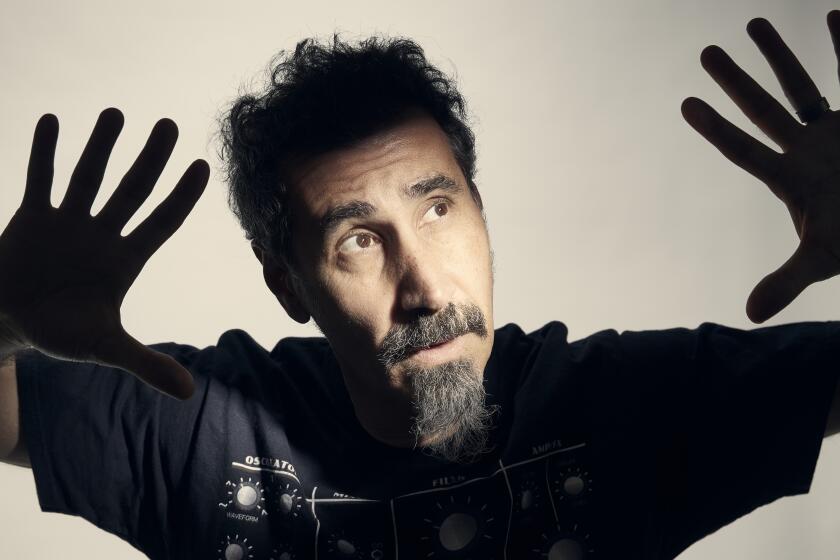Book World Booting Up for a Whole New Chapter : Publishing: CD-Rom has the industry abuzz as the American Booksellers Assn. prepares to gather here for its convention. The prediction? Get ready to curl up with a good computer.
Like surfers waiting for the next wave, booksellers are an anxious bunch these days. They know a big one is coming, they just don’t know where or when.
From coast to coast, the book biz is abuzz with talk of a brave new computerized world. In the future, some experts predict, a tsunami-force wave of CD-ROM technology and other innovations will wash through U.S. bookstores, dramatically transforming the way texts are written, packaged, sold and read.
Within years, they suggest, books will be more than hard-bound bestsellers or mass-market paperbacks. They’ll be three-dimensional, sensory experiences on home computer screens that usher in a new era of literary information. You’ll just pop in a compact disk, turn on the laptop . . . and read.
Few are predicting the demise of books as we know them, because it’s hard to imagine your PowerBook at the beach, or bedtime stories with the kids in front of an impersonal computer. But in a nation where 32% of all homes have PCs, the demand for electronic book products could become insatiable.
“There’s a change coming and we have to stake our claim to this new market,” says Doug Dutton, owner of Dutton’s Books in Brentwood. “Yet that’s all we know. We booksellers have a lot of questions about where we’re headed.”
They’ll be seeking answers starting Saturday, when more than 30,000 publishers, authors, booksellers, agents and other vendors gather in Los Angeles for the annual American Booksellers Assn. convention. The four-day event is the largest book conference in the English-speaking world.
As in previous meetings, there will be lavish signing parties, gala dinners and no shortage of literary hoopla. Some of the nation’s foremost writers will be in attendance: Tony Kushner, Tom Robbins, Maya Angelou, Dave Barry, Michael Crichton, Allen Ginsburg, Matt Groening, Dean Koontz, Amy Tan, Tom Peters, Anne Rivers Siddons, John Irving and Pat Conroy.
There will be glitz and dish galore when lovebugs James Carville and Mary Matalin preview their joint account of what it was like to be on opposing sides of the 1992 Clinton-Bush campaigns. On a local note, author panels will delve into the literature of the 1992 Los Angeles riots and the image of the City of Angels as reflected in novels, poetry, short stories and memoirs.
Much of the informal buzz, however, is expected to focus on electronic publishing, a relatively new branch of the book business that’s gathering more force each year. For the first time, the ABA will be devoting a sizable chunk of convention floor space to computer book products. The market has clearly grabbed sellers’ attention--but will they be able to ride the new wave?
“That’s the $64,000 question,” says Elisa Zachary, publisher of Simon & Schuster’s interactive division, which is less than a year old. “You have to train people to sell these products, and consumers have to become more aware. Maybe they’ve heard about electronic books. But they don’t know much more.”
*
On the surface, it looks simple: CD-ROM technology records the text of a book on compact disk to be read on a computer screen. The experience is often enhanced with sound, graphics and material not found in the original book.
The most dramatic feature of the new product, however, is interactive: It enables people to “talk back” to the text with the mere click of a computer switch. From a creative standpoint, the possibilities are endless.
In a future CD-ROM book, for example, readers could step into a novel, invent characters and change plots. The technology already exists for kids to watch Velociraptors crossing a Mongolian plain, as they click their way through a book about dinosaurs. History has been enhanced for many college students, who now can look up Hitler, Lenin or Stalin in an on-line encyclopedia and see grainy films of them delivering speeches on home computer screens.
Publishers are calling it the ultimate marriage of reading and entertainment. But they caution that electronic books and their ilk are like many other futuristic products rolling down the new information superhighway.
“Right now it’s all talk and speculation,” says a high-ranking executive of a major American booksellers chain. “Everybody knows the potential here is going to be vast and huge . . . but it’s up to consumers to make this fly.”
Currently, there are only a limited number of CD-ROM book products on the market, ranging from the complete Oxford English Dictionary to a group of children’s stories, including “Just Grandma and Me,” which has sold more than 130,000 copies. Customers seeking them out in bookstores may be disappointed because many stores don’t yet carry a full product line.
Indeed, CD-ROM books are more typically found in computer stores such as Egghead Software and Comp USA. Booksellers hope to correct that so they don’t lose the market. And publishers are also feeling the heat, because they don’t want to merely provide the back list of material for others to re-create on CD-ROM. For them, the big bucks will be in marketing and distribution.
“We’re rethinking what it means to be a publisher, and we’re trying to move as many products on paper into electronics,” says Randi Benton, who runs the interactive computer division of Random House Inc. “But everybody has to proceed cautiously, because there are some obvious business concerns.”
Such as: How do you bet the farm on a new medium when fewer than 5 million American homes have CD-ROM technology in their computers? Will enough customers buy electronic books that typically sell for $69.99 or more?
Most important, what happens if compact disk technology becomes the eight-track tape of the 1990s--an obsolete hardware that’s overtaken by new gadgetry?
“I don’t think it really matters that much,” says Bob Stein, a creative guru at the Voyager Co., a New York-based firm that creates CD-ROM books. “Did the Beatles suffer when eight-track tapes gave way to cassettes? They did just fine and so did their audience. The point is, change will happen.”
*
Stein should know. Working with author Art Spiegelman, he recently unveiled a stunning example of what CD-ROM technology can do to an already superb product. Spiegelman’s “Maus,” an award-winning cartoon that chronicled the horror of the Holocaust through the eyes of a mouse and other characters, has been transformed into a provocative new computer-book experience.
Along with the original text and drawings, readers can tap into several hours of audiotapes featuring Spiegelman’s father, on whose life the book was based. There’s a running commentary by the author, describing his creative process, as well as thousands of additional sketches, maps and documents that helped create the world of “Maus.”
It’s a richer reading experience by far.
“You’re entering a whole new world,” Stein says. “Reading used to be something where you only used one of five senses, but now at least we’ve added a second, which is hearing. We’ve enlarged the band width, so to speak.
“And we’re going to see a time when many writers no longer just rely on the printed page to communicate. They’ll be using the computer as a larger locus of expression. That’s where you’ll find our forward-looking writers.”
The new technology also permits a richer look at the past. In the recently published diaries of Richard Nixon presidential aide H.R. Haldeman, for example, readers of the printed book can thumb through 684 pages of text. But the CD-ROM version just issued by Sony Electronics includes an expanded text as well as 45 minutes of rare home movies of Nixon shot by Haldeman.
Booksellers are watching and waiting to see how the new medium performs, but there are some preliminary indications it will be quite popular.
Bernard Rath, ABA executive director, notes that the introduction of on-line encyclopedias has caused a 10%-12% dip in sales of printed versions.
“It would be a shame if we don’t seize the advantage and get in the forefront of this,” he says. “Our goal is to make the bookstore perceived as the place to go for information or entertainment in any format.”
And the place to start, many say, is with kids.
It’s no accident that Random House is emphasizing children’s products in its initial CD-ROM ventures. Next year, Dr. Seuss’ works will be available on disk, through a joint venture with Random House and Broderbund.
This fall, Simon & Schuster will market a Star Trek junkies’ dream--the operating manual for the USS Enterprise in a bold new computer format, replete with interactive gizmos, color graphics and vivid sound effects.
“Kids are sponges with computers,” Random House’s Benton says. “They absorb this stuff completely, with no fear. They have no barriers. So they’re a natural place for the first waves of this new medium to start appearing.”
More to Read
Sign up for our Book Club newsletter
Get the latest news, events and more from the Los Angeles Times Book Club, and help us get L.A. reading and talking.
You may occasionally receive promotional content from the Los Angeles Times.





